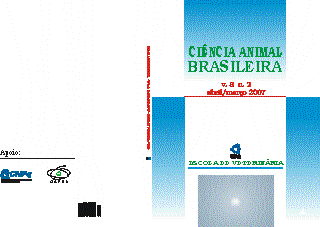CHEMICAL COMPOSITION AND ENERGY ESTIMATION FROM ENSILED CASSAVA MASS WITH WHEAT MEAL IN EXPERIMENTAL SILOS
DOI:
https://doi.org/10.5216/cab.v8i3.1684Keywords:
Silagem, mandiocaAbstract
The experiment was conducted in order to evaluate the pH, chemical composition, fractions which constitute the total carbohydrates (CHT) and energy values of cassava mass silage with wheat meal in PVC silos with capacity for 12 kg, randomly distributed in three replications. The samples had been taken at 0, 6, 18, 25, 45 and 60 days after ensilage. The dry matter (DM), ether extract (EE), crude protein (CP), neutral detergent fiber (NDF), acid detergent fiber (ADF), non-fiber carbohydrates (NFC), lignin contents and pH, CHT fraction and energy were analyzed. There was linear effect (P<0.05) for pH values, that decreased with the ensilage time, and positive quadratic effect (P<0.05) for DM concentration. The CP, EE, NDF, ADF, lignin, CHT texts of PB, EE, FDN, FDA, lignin, CHT, CNF, total fractions of CHT, total digestible nutrients and energy contents were constant (P>0.05) in function of the ensilage time. In func-tion of the results, the cassava silage is showed as alternative source of energy concentrate for ruminants feeding.
KEY-WORDS: Animal nutrition, byproducts, conservation, energy.
Downloads
Downloads
Published
How to Cite
Issue
Section
License
Authors who publish with this journal agree to the following terms:
- Authors retain copyright and grant the journal right of first publication with the work simultaneously licensed under a Creative Commons Attribution License that allows others to share the work with an acknowledgement of the work's authorship and initial publication in this journal.
- Authors are able to enter into separate, additional contractual arrangements for the non-exclusive distribution of the journal's published version of the work (e.g., post it to an institutional repository or publish it in a book), with an acknowledgement of its initial publication in this journal.
- Authors are permitted and encouraged to post their work online (e.g. in institutional repositories or on their website) prior to and during the submission process, as it can lead to productive exchanges, as well as earlier and greater citation of published work (See The Effect of Open Access).




























